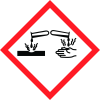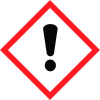Iron(III) chloride
Sigma-Aldrich Chemie GmbH
Revision date : 2021-05-28


General Information
Revision date
2021-05-28
Product name
Iron(III) chloride
CAS No.
7705-08-0
REACH No
01-2119497998-05-XXXX
Emergency telephone
+49 (0)696 43508409
Icons in SDS
Company Information
Company name
Sigma-Aldrich Chemie GmbH
E-mail address of the competent person responsible for the Safety Data Sheet
technischerservice@merckgroup.com
GHS Information
Signal word
Danger
Hazard Codes
Hazard statements (CLP)
H290, H302, H315, H318
Hazard statements
Code
Statements
H290
May be corrosive to metals
H302
Harmful if swallowed
H315
Causes skin irritation
H318
Causes serious eye damage
Precautionary statements
Code
Statements
P234
Keep only in original container.
P264
Wash ... thoroughly after handling.
P280
Wear protective gloves/protective clothing/eye protection/face protection.
P301+P312
IF SWALLOWED: call a POISON CENTER/doctor/... IF you feel unwell.
P302+P352
IF ON SKIN: wash with plenty of water.
P305+P351+P338
IF IN EYES: Rinse cautiously with water for several minutes. Remove contact lenses if present and easy to do - continue rinsing.
Section 2
2.1 Classification of the substance or mixture
Classification
2.2 Label elements
Labelling
Signal word
Danger Danger
Hazard statements
H290 May be corrosive to metals. H302 Harmful if swallowed. H315 Causes skin irritation. H318 Causes serious eye damage. Reduced Labeling (<= 125 ml) H318 Causes serious eye damage.
Precautionary statements
P234 Keep only in original packaging. P264 Wash skin thoroughly after handling. P280 Wear protective gloves/ eye protection/ face protection. P301 + P312 IF SWALLOWED: Call a POISON CENTER/ doctor if you feel unwell. P302 + P352 IF ON SKIN: Wash with plenty of water. P305 + P351 + P338 IF IN EYES: Rinse cautiously with water for several minutes. Remove contact lenses, if present and easy to do. Continue rinsing. P305 + P351 + P338 IF IN EYES: Rinse cautiously with water for several minutes. Remove contact lenses, if present and easy to do. Continue rinsing.
Supplemental label elements
none none
2.3 Other hazards
This substance/mixture contains no components considered to be either persistent, bioaccumulative and toxic (PBT), or very persistent and very bioaccumulative (vPvB) at levels of 0.1% or higher.

